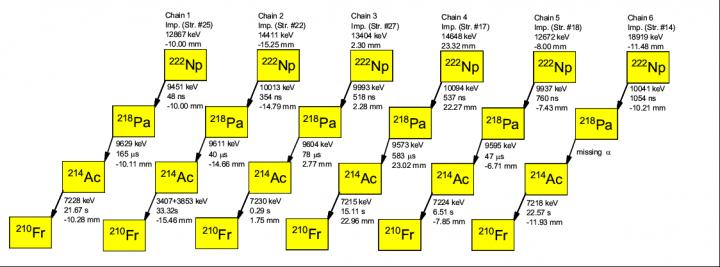
Credit: IMP
In a recent study, researchers at the Institute of Modern Physics (IMP) of the Chinese Academy of Science (CAS) and their collaborators reported the first discovery of 222Np, a new very short-lived neptunium (Np) isotope, and validated the N = 126 shell effect in Np isotopes.
The experiment, led by Prof. GAN Zaiguo of IMP, was carried out at the Heavy Ion Research Facility in Lanzhou. And the study was published in Physical Review Letters on July 13.
In the trans-lead neutron-deficient region, nuclides decay pervasively by emitting α particles. Therefore, α-decay spectroscopy, an old yet powerful tool in nuclear physics, has been employed generally to identify new heavy isotopes and to investigate the shell evolution and the nuclear structure of ground and excited states in this region.
In previous research, a weakening of the influence of the N = 126 shell closure towards Z = 92 uranium was observed experimentally. The question then arises how the N = 126 shell will evolve above Z = 92.
In the present work, researchers synthesized a very short-lived α-emitting isotope 222Np (N = 129), which is one of Np isotopes just above the N = 126 closed shell. The new isotope was produced in the complete-fusion reaction and observed at the gas-filled recoil separator SHANS. And it was identified by employing the recoil-α correlation measurement.
Researchers then established six α-decay chains and determined the decay properties of 222Np.
These experimental findings are important for improving the α-decay systematics of Np isotopes around N = 126. By combining the results with the existing data, researchers obtained the convincing evidence for the stability of the N = 126 magic shell in Np isotopes. The study clarifies the question how robust the N = 126 shell is in Np isotopes.
This work was supported by the Strategic Priority Research Program of CAS, the National Key R&D Program of China, the National Natural Science Foundation of China, etc.
###
Media Contact
LIU Fang
[email protected]
Original Source
http://english.
Related Journal Article
http://dx.




